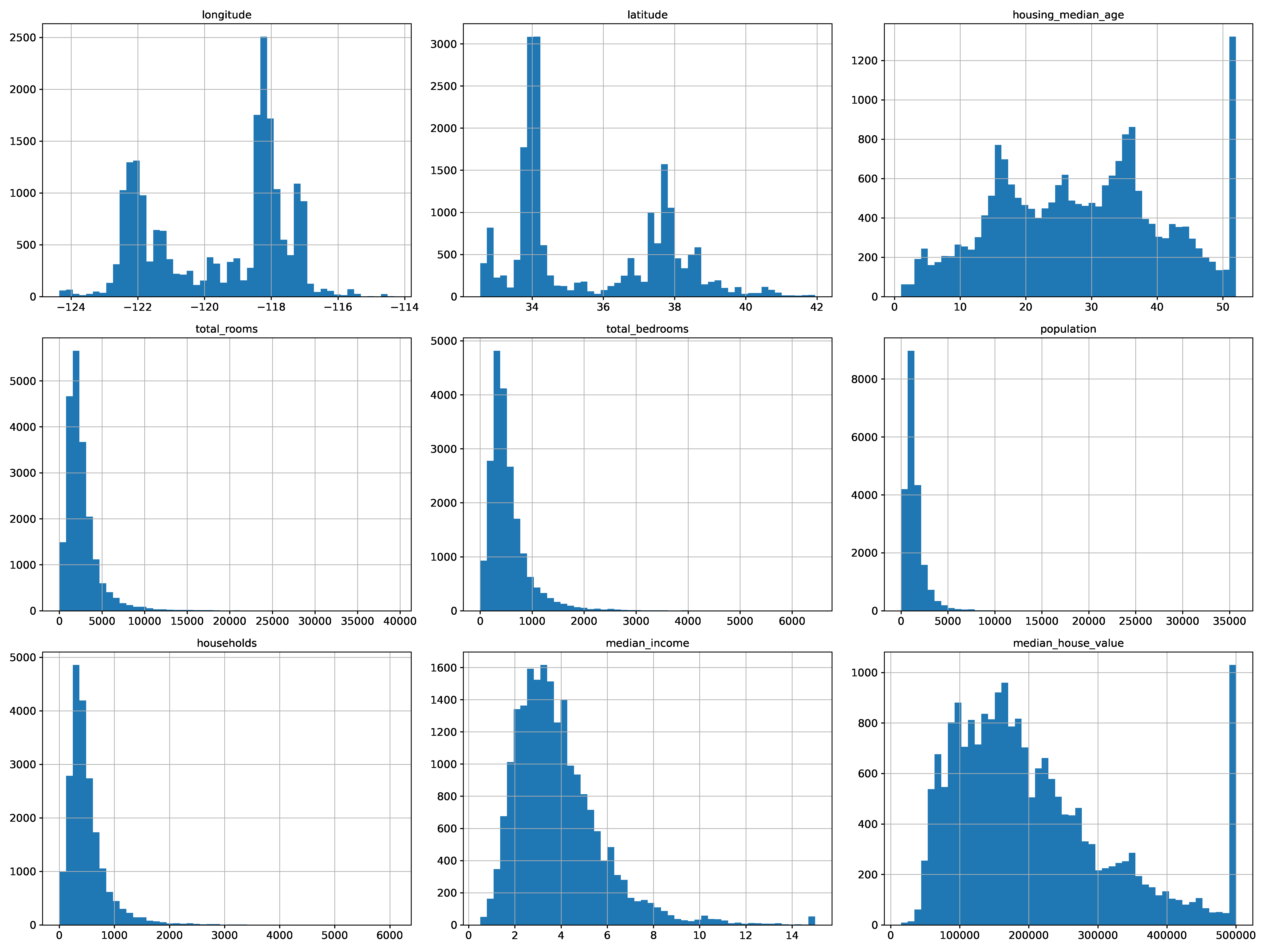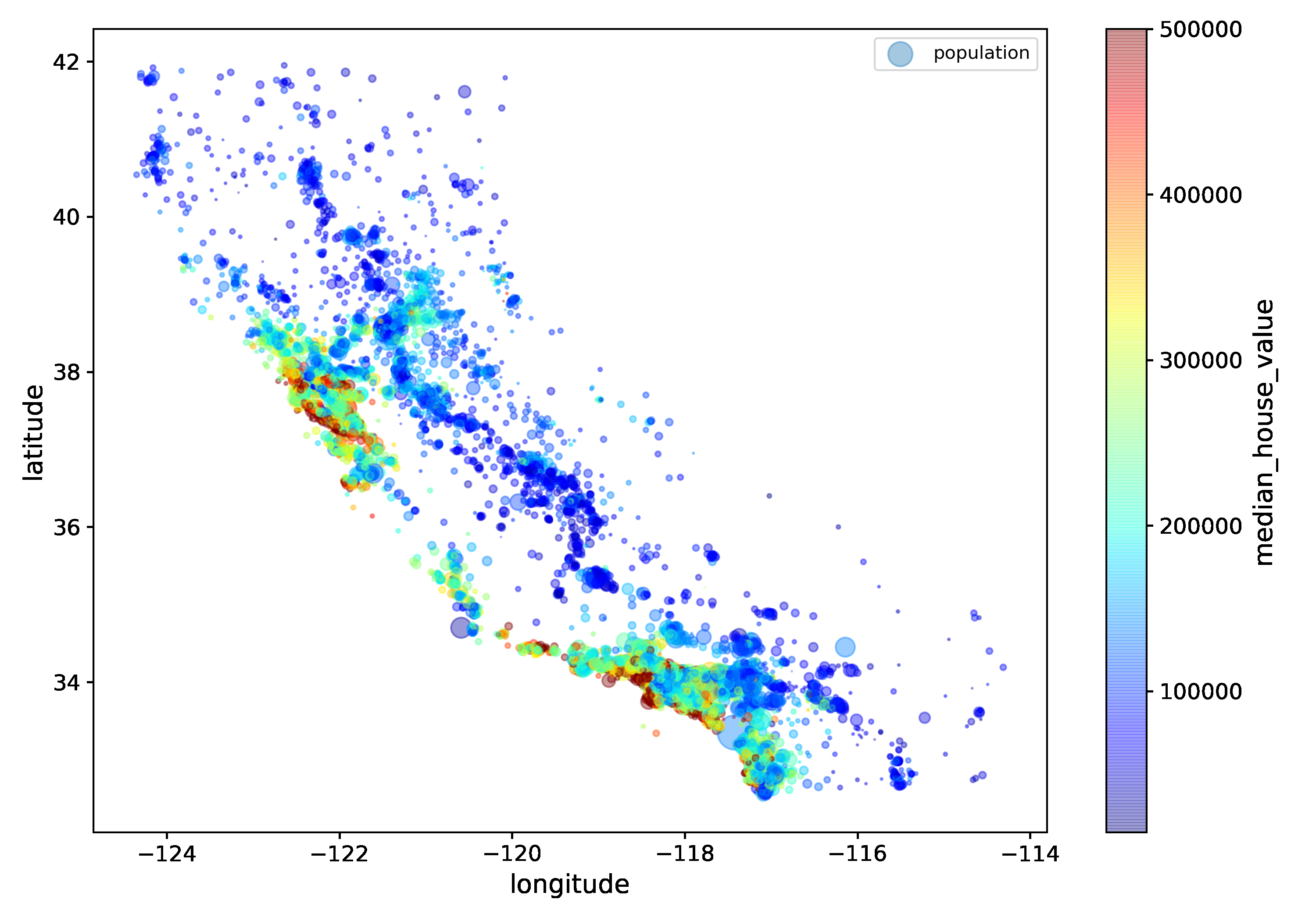End-to-End 머신러닝 프로젝트
부동산 회사에 막 고용된 데이터 과학자라고 가정하고 예제 프로젝트를 진행해보자. 주요 단계는 다음과 같다. 캘리포니아 주택 가격 데이터셋을 사용한다. Original Code
- Look at the big picture.
- Get the data.
- Discover and visualize the data to gain insights.
- Prepare the data for Machine Learning algorithms.
- Select a model and train it.
- Fine-tune your model.
- Present your solution.
- Launch, monitor, and maintain your system.
1. 큰 그림 보기
모델이 전체 시스템 안에서 어떻게 사용될 지를 이해하는 것이 중요하다.
- 풀어야 할 문제: 캘리포니아 인구조사 데이터를 사용해 캘리포니아의 주택 가격 모델을 만드는 것
- 중요한 질문: 현재 솔루션은? 전문가가 수동으로? 복잡한 규칙? 머신러닝?
문제 정의
- 지도학습, 비지도학습, 강화학습 중에 어떤 경우에 해당하는가?
- 분류문제인가, 아니면 회귀문제인가?
- 배치학습(=오프라인학습), 온라인학습(=점진적학습) 중 어떤 것을 사용해야 하는가? 차이점은 여기참고!
성능측정지표(performance measure) 선택
- 평균제곱근 오차(root mean square error (RMSE))
- : 데이터셋에 있는 샘플 수
- : 번째 샘플의 전체 특성값의 벡터(vector)
- : 번째 샘플의 label(해당 샘플의 기대 출력값)
- : 데이터셋 모든 샘플의 모든 특성값(features)을 포함하는 행렬(matrix)
- : 예측함수(prediction function). 하나의 샘플 에 대해 예측값 를 출력함.
2. 데이터 가져오기
import os
import tarfile
import urllib
DOWNLOAD_ROOT = "https://raw.githubusercontent.com/ageron/handson-ml2/master/"
HOUSING_PATH = os.path.join("datasets", "housing")
HOUSING_URL = DOWNLOAD_ROOT + "datasets/housing/housing.tgz"
def fetch_housing_data(housing_url=HOUSING_URL, housing_path=HOUSING_PATH):
if not os.path.isdir(housing_path):
os.makedirs(housing_path)
tgz_path = os.path.join(housing_path, "housing.tgz")
urllib.request.urlretrieve(housing_url, tgz_path)
housing_tgz = tarfile.open(tgz_path)
housing_tgz.extractall(path=housing_path)
housing_tgz.close()
# fetch_housing_data를 호출하면 현재 작업공간에 datasets/housing 디렉토리를 만들고
# housing.tgz 파일을 내려받고 압축을 풀어 housing.csv 파일을 만듭니다.
fetch_housing_data()
-
데이터 구조 훑어보기

-
히스토그램으로 데이터 분석해보기
%matplotlib inline
import matplotlib.pyplot as plt
housing.hist(bins=50, figsize=(20,15))
save_fig("attribute_histogram_plots")
plt.show()
테스트 데이터셋 만들기
좋은 모델을 만들기 위해선 훈련에 사용되지 않고 모델평가만을 위해서 사용될 "테스트 데이터셋"을 따로 구분하는 것이 필요
- 계층적 샘플링(stratified sampling)
- 전체 데이터를 계층(strata)라는 동질의 그룹으로 나누고, 테스트 데이터가 전체 데이터를 잘 대표하도록 각 계층에서 올바른 수의 샘플을 추출
# 직관적으로, 집의 가격와 가계 수입이 관련이 있을 것으로 판단되므로
# median_income 변수를 사용해 전체 데이터를 계층화하자.
# 연속형 변수를 5개 카테고리로 범주화
housing["income_cat"] = pd.cut(housing["median_income"],
bins=[0., 1.5, 3.0, 4.5, 6., np.inf],
labels=[1, 2, 3, 4, 5])
from sklearn.model_selection import StratifiedShuffleSplit
split = StratifiedShuffleSplit(n_splits=1, test_size=0.2, random_state=42)
for train_index, test_index in split.split(housing, housing['income_cat']):
strat_train_set = housing.loc[train_index]
strat_test_set = housing.loc[test_index] 3. 데이터 이해를 위한 탐색과 시각화
- 지리적 데이터 시각화
- alpha 옵션을 사용해서 밀집된 영역은 더 진하게 표시해보자.- s: 원의 반지름으로 인구 수를 표현
- c: 색상으로 가격을 표현
housing.plot(kind="scatter", x="longitude", y="latitude", alpha=0.4,
s=housing["population"]/100, label="population", figsize=(10,7),
c="median_house_value", cmap=plt.get_cmap("jet"), colorbar=True,
sharex=False)
plt.legend()
save_fig("housing_prices_scatterplot")
상관관계(Correlations) 관찰하기
corr_matrix = housing.corr()
corr_matrix["median_house_value"].sort_values(ascending=False)
## output
# median_house_value 1.000000
# median_income 0.687160
# total_rooms 0.135097
# housing_median_age 0.114110
# households 0.064506
# total_bedrooms 0.047689
# population -0.026920
# longitude -0.047432
# latitude -0.142724
# Name: median_house_value, dtype: float64- scatter_matrix 사용
# from pandas.tools.plotting import scatter_matrix # For older versions of Pandas
from pandas.plotting import scatter_matrix
# 특성 몇 개만 살펴봄
attributes = ["median_house_value", "median_income", "total_rooms",
"housing_median_age"]
scatter_matrix(housing[attributes], figsize=(12, 8))
save_fig("scatter_matrix_plot")
특성 조합들 실험
여러 특성(feature, attribute)들의 조합으로 새로운 특성을 정의해볼 수 있다.
# 예를 들자면, 가구당 방 개수, 침대방(bedroom)의 비율, 가구당 인원
housing["rooms_per_household"] = housing["total_rooms"]/housing["households"]
housing["bedrooms_per_room"] = housing["total_bedrooms"]/housing["total_rooms"]
housing["population_per_household"]=housing["population"]/housing["households"]
corr_matrix = housing.corr()
corr_matrix["median_house_value"].sort_values(ascending=False)
## output
# median_house_value 1.000000
# median_income 0.687160
# rooms_per_household 0.146285
# total_rooms 0.135097
# housing_median_age 0.114110
# households 0.064506
# total_bedrooms 0.047689
# population_per_household -0.021985
# population -0.026920
# longitude -0.047432
# latitude -0.142724
# bedrooms_per_room -0.259984
# Name: median_house_value, dtype: float64- 위에서 관찰할 수 있는 사실들?
- bedrooms_per_room: 집값과 강한 음의 상관관계 (집이 클수록 침실의 비율은 작아질 것)
- rooms_per_household: 집값과 양의 상관관계 (방이 많을수록 집이 클 것이고, 집이 크면 집값도 비쌀 것)
4. 머신러닝 알고리즘을 위한 데이터 준비
데이터 준비는 데이터 변환(data transformation)과정으로 볼 수 있다.
데이터 정제(Data Cleaning)
- 누락된 값(missing value, 결측치)을 다루는 방법들
- 해당 구역을 제거(행을 제거)
- 해당 특성을 제거(열을 제거)
- 어떤 값으로 채움(0, 평균, 중간값 등) 가장 추천하는 방법
# 결측치를 가지는 행들 샘플
sample_incomplete_rows = housing[housing.isnull().any(axis=1)].head() # True if there is a null feature
# option 1(행을 제거)
sample_incomplete_rows.dropna(subset=["total_bedrooms"])
# option 2(열을 제거)
sample_incomplete_rows.drop("total_bedrooms", axis=1)
# option 3(중앙값으로 채움)
median = housing["total_bedrooms"].median()
sample_incomplete_rows["total_bedrooms"].fillna(median, inplace=True)
- SimpleImputer 사용하기
from sklearn.impute import SimpleImputer
imputer = SimpleImputer(strategy="median") # 중앙값으로 채우기
# 중간값은 수치형 특성에서만 계산될 수 있기 때문에 텍스트 특성을 제외한 복사본을 생성
housing_num = housing.drop("ocean_proximity", axis=1)
imputer.fit(housing_num)
# 학습된 imputer 객체를 사용해 누락된 값을 중간값으로 채울 수 있다.
X = imputer.transform(housing_num)
# X는 numpy array이므로 이를 다시 pandas DataFrame으로 바꾸자.
housing_tr = pd.DataFrame(X, columns=housing_num.columns,
index=housing.index)Estimator, Transformer, Predictor 개념
-
추정기(estimator)
- 데이터셋을 기반으로 모델 파라미터들을 추정하는 객체(예를 들자면 imputer).- 추정자체는 fit() method에 의해서 수행되고 하나의 데이터셋을 매개변수로 전달받는다.
- 지도학습의 경우 label을 담고 있는 데이터셋을 추가적인 매개변수로 전달한다.
-
변환기(transformer):
- (imputer같이) 데이터셋을 변환하는 추정기- 변환은 transform() method가 수행하고 변환된 데이터셋을 반환한다.
-
예측기(predictor)
- 일부 추정기는 주어진 새로운 데이터셋에 대해 예측값을 생성할 수 있다.- 예측기의 predict() method는 새로운 데이터셋을 받아 예측값을 반환한다.
- score() method는 예측값에 대한 평가지표를 반환한다.
텍스트와 범주형 특성 다루기
- OrdinalEncoder
- "특성의 값이 비슷할수록 두 개의 샘플이 비슷하다"가 성립할 때 모델학습이 쉬워진다.
# 범주형 특성
housing_cat = housing[["ocean_proximity"]]
from sklearn.preprocessing import OrdinalEncoder
ordinal_encoder = OrdinalEncoder()
housing_cat_encoded = ordinal_encoder.fit_transform(housing_cat)
ordinal_encoder.categories_
## output
# [array(['<1H OCEAN', 'INLAND', 'ISLAND', 'NEAR BAY', 'NEAR OCEAN'], dtype=object)]- OneHotEncoder
from sklearn.preprocessing import OneHotEncoder
cat_encoder = OneHotEncoder(sparse=False)
housing_cat_1hot = cat_encoder.fit_transform(housing_cat)
housing_cat_1hot나만의 변환기(Custom Transformers) 만들기
프로젝트를 위해 특별한 데이터 처리 작업을 해야 할 경우, 직접 변환기를 만들 수 있다. 반드시 구현해야 할 method는 fit()과 transform()이다.
아래의 custom tranformer는 rooms_per_household, population_per_household 두 개의 새로운 특성을 데이터셋에 추가하며 add_bedrooms_per_room = True로 주어지면 bedrooms_per_room 특성까지 추가한다. (add_bedrooms_per_room은 하이퍼파라미터로, 나중에 여러 조합을 테스트할 때 유용하다.)
from sklearn.base import BaseEstimator, TransformerMixin
# column index 저장
rooms_ix, bedrooms_ix, population_ix, households_ix = 3, 4, 5, 6
class CombinedAttributesAdder(BaseEstimator, TransformerMixin):
def __init__(self, add_bedrooms_per_room = True): # no *args or **kargs
self.add_bedrooms_per_room = add_bedrooms_per_room
def fit(self, X, y=None):
return self # nothing else to do
def transform(self, X): # X는 numpy array
rooms_per_household = X[:, rooms_ix] / X[:, households_ix]
population_per_household = X[:, population_ix] / X[:, households_ix]
if self.add_bedrooms_per_room:
bedrooms_per_room = X[:, bedrooms_ix] / X[:, rooms_ix]
return np.c_[X, rooms_per_household, population_per_household,
bedrooms_per_room]
else:
return np.c_[X, rooms_per_household, population_per_household]
attr_adder = CombinedAttributesAdder(add_bedrooms_per_room=False)
housing_extra_attribs = attr_adder.transform(housing.values)
# numpy 데이터를 dataframe으로 변환
housing_extra_attribs = pd.DataFrame(
housing_extra_attribs,
columns=list(housing.columns)+["rooms_per_household", "population_per_household"],
index=housing.index)
housing_extra_attribs.head()특성 스케일링(Feature Scaling)
- Min-max scaling
- 0과 1사이의 값이 되도록 조정 - 표준화(standardization)
- 평균이 0, 분산이 1이 되도록 만들어 줌(sklearn의 StandardScaler사용)
변환 파이프라인(Transformation Pipelines)
여러 개의 변환이 순차적으로 이루어져야 할 경우 Pipeline class를 사용하면 편리하다.
- Pipeline 사용하기
- 이름, 추정기 쌍의 목록이 필요
- 마지막 단계를 제외하고 모두 변환기(즉, fit_transform() method를 가지고 있어야 함).
- 파이프라인의 fit() method를 호출하면 모든 변환기의 fit_transform() method를 순서대로 호출하면서 한 단계의 출력을 다음 단계의 입력으로 전달한다.
- 마지막 단계에서는 fit() method만 호출
from sklearn.pipeline import Pipeline
from sklearn.preprocessing import StandardScaler
num_pipeline = Pipeline([
('imputer', SimpleImputer(strategy="median")), # median으로 결측치 채우기
('attribs_adder', CombinedAttributesAdder()), # 새로운 특성 추가하기
('std_scaler', StandardScaler()), # 표준화하기
])
housing_num_tr = num_pipeline.fit_transform(housing_num)- ColumnTransformer로 각 열(column) 마다 다른 파이프라인을 적용
- 예를 들어 수치형 특성들과 범주형 특성들에 대해 별도의 변환이 필요한 경우
from sklearn.compose import ColumnTransformer
num_attribs = list(housing_num) # 수치형 특성들
cat_attribs = ["ocean_proximity"] # 범주형 특성
full_pipeline = ColumnTransformer([
("num", num_pipeline, num_attribs),
("cat", OneHotEncoder(), cat_attribs),
])
housing_prepared = full_pipeline.fit_transform(housing)5. 모델 훈련
선형회귀모델(linear regression) 사용
from sklearn.linear_model import LinearRegression
lin_reg = LinearRegression()
lin_reg.fit(housing_prepared, housing_labels)- RMSE 측정
# 전체 훈련 데이터셋에 대한 RMSE를 측정
from sklearn.metrics import mean_squared_error
housing_predictions = lin_reg.predict(housing_prepared)
lin_mse = mean_squared_error(housing_labels, housing_predictions)
lin_rmse = np.sqrt(lin_mse)
lin_rmse
## output
# 68628.19819848923훈련 데이터셋의 RMSE가 이 경우처럼 큰 경우, 과소적합(under-fitting)이라고 판단된다.
- 과소적합이 일어나는 이유?
- 특성들(features)이 충분한 정보를 제공하지 못함
- 모델이 충분히 강력하지 못함
DecisionTreeRegressor 사용
from sklearn.tree import DecisionTreeRegressor
tree_reg = DecisionTreeRegressor(random_state=42)
tree_reg.fit(housing_prepared, housing_labels)
housing_predictions = tree_reg.predict(housing_prepared)
tree_mse = mean_squared_error(housing_labels, housing_predictions)
tree_rmse = np.sqrt(tree_mse)
tree_rmse
## output
# 0.0RandomForestRegressor 사용
from sklearn.ensemble import RandomForestRegressor
forest_reg = RandomForestRegressor(n_estimators=100, random_state=42)
forest_reg.fit(housing_prepared, housing_labels)
housing_predictions = forest_reg.predict(housing_prepared)
forest_mse = mean_squared_error(housing_labels, housing_predictions)
forest_rmse = np.sqrt(forest_mse)
forest_rmse
## output
# 18603.515021376355교차 검증(Cross-Validation)을 사용한 평가

from sklearn.model_selection import cross_val_score
def display_scores(scores):
print("Scores:", scores)
print("Mean:", scores.mean())
print("Standard deviation:", scores.std())
# 결정트리모델에 대한 평가
scores = cross_val_score(tree_reg, housing_prepared, housing_labels,
scoring="neg_mean_squared_error", cv=10)
tree_rmse_scores = np.sqrt(-scores)
display_scores(tree_rmse_scores)
## output
# Scores: [70194.33680785 66855.16363941 72432.58244769 70758.73896782
# 71115.88230639 75585.14172901 70262.86139133 70273.6325285
# 75366.87952553 71231.65726027]
# Mean: 71407.68766037929
# Standard deviation: 2439.4345041191004
# 선형회귀모델에 대한 평가
lin_scores = cross_val_score(lin_reg, housing_prepared, housing_labels,
scoring="neg_mean_squared_error", cv=10)
lin_rmse_scores = np.sqrt(-lin_scores)
display_scores(lin_rmse_scores)
## output
# Scores: [66782.73843989 66960.118071 70347.95244419 74739.57052552
# 68031.13388938 71193.84183426 64969.63056405 68281.61137997
# 71552.91566558 67665.10082067]
# Mean: 69052.46136345083
# Standard deviation: 2731.6740017983498
# RandomForestRegressor에 대한 평가
forest_scores = cross_val_score(forest_reg, housing_prepared, housing_labels,
scoring="neg_mean_squared_error", cv=10)
forest_rmse_scores = np.sqrt(-forest_scores)
display_scores(forest_rmse_scores)
## output
# Scores: [49519.80364233 47461.9115823 50029.02762854 52325.28068953
# 49308.39426421 53446.37892622 48634.8036574 47585.73832311
# 53490.10699751 50021.5852922 ]
# Mean: 50182.303100336096
# Standard deviation: 2097.0810550985693
# RandomForestRegressor를 최종 모델로 채택한다.6. 모델 세부 튜닝
모델의 종류를 선택한 후, 모델 학습을 위한 최적의 하이퍼파라미터를 찾는 과정
- 그리드 탐색(Grid Search); GridSearchCV 사용
from sklearn.model_selection import GridSearchCV
param_grid = [
# try 12 (3×4) combinations of hyperparameters
{'n_estimators': [3, 10, 30], 'max_features': [2, 4, 6, 8]},
# then try 6 (2×3) combinations with bootstrap set as False
{'bootstrap': [False], 'n_estimators': [3, 10], 'max_features': [2, 3, 4]},
]
forest_reg = RandomForestRegressor(random_state=42)
# train across 5 folds, that's a total of (12+6)*5=90 rounds of training
grid_search = GridSearchCV(forest_reg, param_grid, cv=5,
scoring='neg_mean_squared_error',
return_train_score=True)
grid_search.fit(housing_prepared, housing_labels)
grid_search.best_estimator_
## output
# RandomForestRegressor(max_features=8, n_estimators=30, random_state=42)- 랜덤 탐색(Randomized Search); RandomizedSearchCV 사용
- 하이퍼파라미터 조합의 수가 큰 경우에 유리하며, 지정한 횟수만큼만 평가한다.
from sklearn.model_selection import RandomizedSearchCV
from scipy.stats import randint
param_distribs = {
'n_estimators': randint(low=1, high=200),
'max_features': randint(low=1, high=8),
}
forest_reg = RandomForestRegressor(random_state=42)
rnd_search = RandomizedSearchCV(forest_reg, param_distributions=param_distribs,
n_iter=10, cv=5, scoring='neg_mean_squared_error', random_state=42)
rnd_search.fit(housing_prepared, housing_labels)
rnd_search.best_estimator_
## output
# RandomForestRegressor(max_features=7, n_estimators=180, random_state=42)- 특성 중요도, 에러 분석
feature_importances = grid_search.best_estimator_.feature_importances_
extra_attribs = ["rooms_per_hhold", "pop_per_hhold", "bedrooms_per_room"]
#cat_encoder = cat_pipeline.named_steps["cat_encoder"] # old solution
cat_encoder = full_pipeline.named_transformers_["cat"]
cat_one_hot_attribs = list(cat_encoder.categories_[0])
attributes = num_attribs + extra_attribs + cat_one_hot_attribs
sorted(zip(feature_importances, attributes), reverse=True)
## output
# [(0.36615898061813423, 'median_income'),
# (0.16478099356159054, 'INLAND'),
# (0.10879295677551575, 'pop_per_hhold'),
# (0.07334423551601243, 'longitude'),
# (0.06290907048262032, 'latitude'),
# (0.056419179181954014, 'rooms_per_hhold'),
# (0.053351077347675815, 'bedrooms_per_room'),
# (0.04114379847872964, 'housing_median_age'),
# (0.014874280890402769, 'population'),
# (0.014672685420543239, 'total_rooms'),
# (0.014257599323407808, 'households'),
# (0.014106483453584104, 'total_bedrooms'),
# (0.010311488326303788, '<1H OCEAN'),
# (0.0028564746373201584, 'NEAR OCEAN'),
# (0.0019604155994780706, 'NEAR BAY'),
# (6.0280386727366e-05, 'ISLAND')]
7. 테스트 데이터셋으로 최종 평가하기
final_model = grid_search.best_estimator_
X_test = strat_test_set.drop("median_house_value", axis=1)
y_test = strat_test_set["median_house_value"].copy()
X_test_prepared = full_pipeline.transform(X_test)
final_predictions = final_model.predict(X_test_prepared)
final_mse = mean_squared_error(y_test, final_predictions)
final_rmse = np.sqrt(final_mse)
final_rmse
## output
# 47730.226903859278. 론칭, 모니터링, 시스템 유지 보수
상용환경에 배포하기 위해서 데이터 전처리와 모델의 예측이 포함된 파이프라인을 만들어 저장하는 것이 좋다.
full_pipeline_with_predictor = Pipeline([
("preparation", full_pipeline),
("linear", LinearRegression())
])
full_pipeline_with_predictor.fit(housing, housing_labels)
# full_pipeline_with_predictor.predict(some_data)
my_model = full_pipeline_with_predictor
import joblib
joblib.dump(my_model, "my_model.pkl")
#...
my_model_loaded = joblib.load("my_model.pkl")- 론칭 후 시스템 모니터링
- 시간이 지나면 모델이 낙후되면서 성능이 저하
- 자동모니터링: 추천시스템의 경우, 추천된 상품의 판매량이 줄어드는지?
- 수동모니터링: 이미지 분류의 경우, 분류된 이미지들 중 일부를 전문가에게 검토시킴
- 결과가 나빠진 경우- 데이터 입력의 품질이 나빠졌는지? 센서고장?
- 트렌드의 변화? 계절적 요인?
- 유지보수
- 정기적으로 새로운 데이터 수집(레이블)
- 새로운 데이터를 테스트 데이터로, 현재의 테스트 데이터는 학습데이터로 편입
- 다시 학습후, 새로운 테스트 데이터에 기반해 현재 모델과 새 모델을 평가, 비교
전체 프로세스에 고르게 시간을 배분해야 한다!

